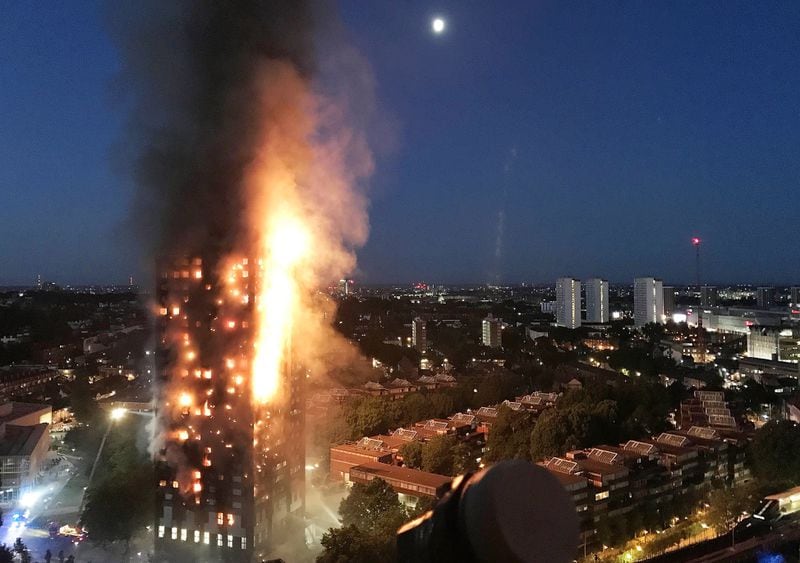UPDATE: Screams alerted residents of a Dubai high-rise that it once again had caught on fire, sending them fleeing as burning debris dripped from the building, according to news reports.
Unlike scores of residents who perished in the fire at London's Grenfell Tower, all residents of Torch tower apparently escaped. But the fire has added to growing concerns about flammable cladding, the Wall Street Journal reports this a.m.
There had been warnings going back at least a decade about such exterior paneling, from a succession of facade fires in Europe, the Middle East and Asia.
Flammable cladding also has been used on buildings in Georgia and other states, a recent AJC investigation found. Read that story by clicking here: http://bit.ly/2v5fB6J
Credit: Johnny Edwards
Credit: Johnny Edwards
Despite the fires, U.S-based manufacturers, including one in Georgia, continued showcasing high-rise buildings said in brochures and marketing materials to be sporting the flammable polyethylene-core exterior panels. Architects and developers went on using the product. Code enforcers kept allowing it.
The AJC found the cheap-but-flammable panels on a metro Atlanta university building and an Atlanta drug and alcohol rehab center, and possibly on a major downtown tourist attraction and on a Florida courthouse.
Below, you can see videos of some fires that preceded Grenfell Tower – buildings whose polyethylene (PE) cladding lit up into a wall of flames. A common culprit: cigarette butts. A common consequence: falling molten debris.
Water Club Tower at the Borgata Casino Hotel, Atlantic City, N.J., 2007
The white, polyethylene panels on the 41-story tower were supposed to resemble a sail, but they wound up resembling a giant torch when a third-floor fire set one side of the building ablaze. Falling debris was reported in a quarter-mile radius. A concrete wall kept the flames from spreading, and the fire eventually burned itself out. The building was still under construction, so no one was injured. Today, it's a five-star luxury hotel.
Wooshin Golden Suites, Busan, South Korea, 2010
The 38-story mixed-use building's golden panels matched its moniker. The building had sprinklers, but not in a fourth-floor garbage collection room where a spark from an electrical outlet ignited a blaze. A wind blowing in from the sea may have fanned the flames, which reached the top of the building within 20 minutes. Firefighters used a helicopter to water bomb the fire. Five people were injured, one of them a firefighter.
Mermoz Tower, Roubaix, France, 2012
As with Grenfell Tower, the 18-story residential building had PE cladding added in a renovation, and residents had expressed concerns about the quality. The paneling covered the middle part of the building's front facade, including walls and balconies. A fire on a second-floor balcony had flames racing up the building within minutes, with smoke billowing into units. Flaming debris rained down. One person died and six people were injured.
Al Tayer Tower, Sharjah, United Arab Emirates, 2012
This fire also started on a lower-level balcony, in this case with a tossed cigarette butt. Flames climbing the 40-story apartment building lit up the night, with families losing pets and all their belongings in a frenzied evacuation. Falling debris damaged dozens of vehicles. Hundreds of families spent months homeless. And UAE found itself in a burning buildings epidemic that would lead to a crackdown on flammable cladding.
Tamweel Tower, Dubai, UAE, 2012
In this case, flames on the 34-story mixed-use tower spread from the top down. PE panels lined the exterior and the decorative roof-top. The fire started with a cigarette butt tossed on a pile of wood and papers left by construction workers. Once the fire reached the roof, molten debris fell to lower balconies and lit up the facade material below. The building took four years to repair, displacing 160 apartment owners.
Lacrosse building, Melbourne, Australia, 2014
A cigarette left on an eighth-floor balcony set a fire that tore its way up the 21-story building's PE panels in 11 minutes. A sprinkler system put out interior flames, allowing residents to evacuate. Investigators found that the panels hadn't been approved for high-rise buildings. The fire prompted Victoria's building authority to review cladding on existing buildings, as British authorities are doing now. National building codes were revamped.
The Address Downtown, Dubai, UAE, 2015
Guests had packed the 63-story hotel and apartment building for a clear view of New Year's Eve fireworks. A spark from a cable connected to a ledge spotlight set off the blaze, which engulfed the building as the fireworks went on as planned. Alarms didn't go off at first, since the smoke was outside, and fleeing guests created a stampede. Fifteen people were injured; one person had a heart attack during the evacuation.
NOTE: The preceding list was based on news reports as well as a 2014 report by the Fire Protection Research Foundation titled "Fire Hazards of Exterior Wall Assemblies Containing Combustible Components."






